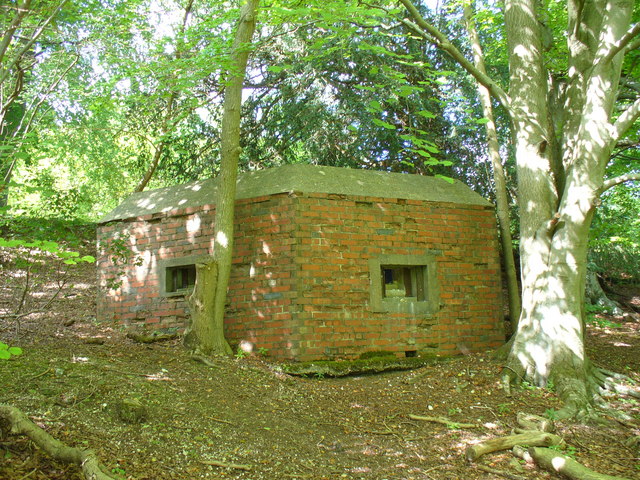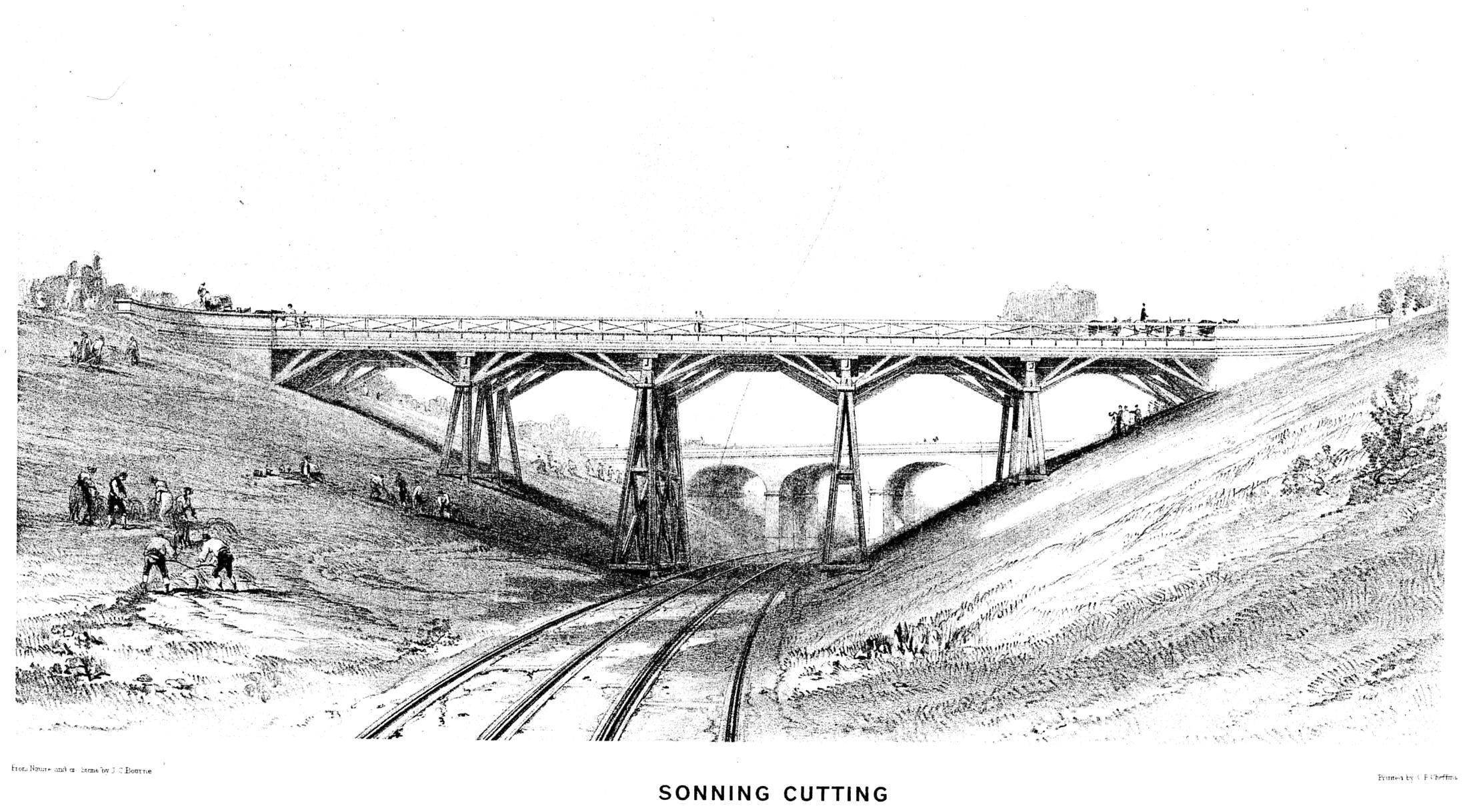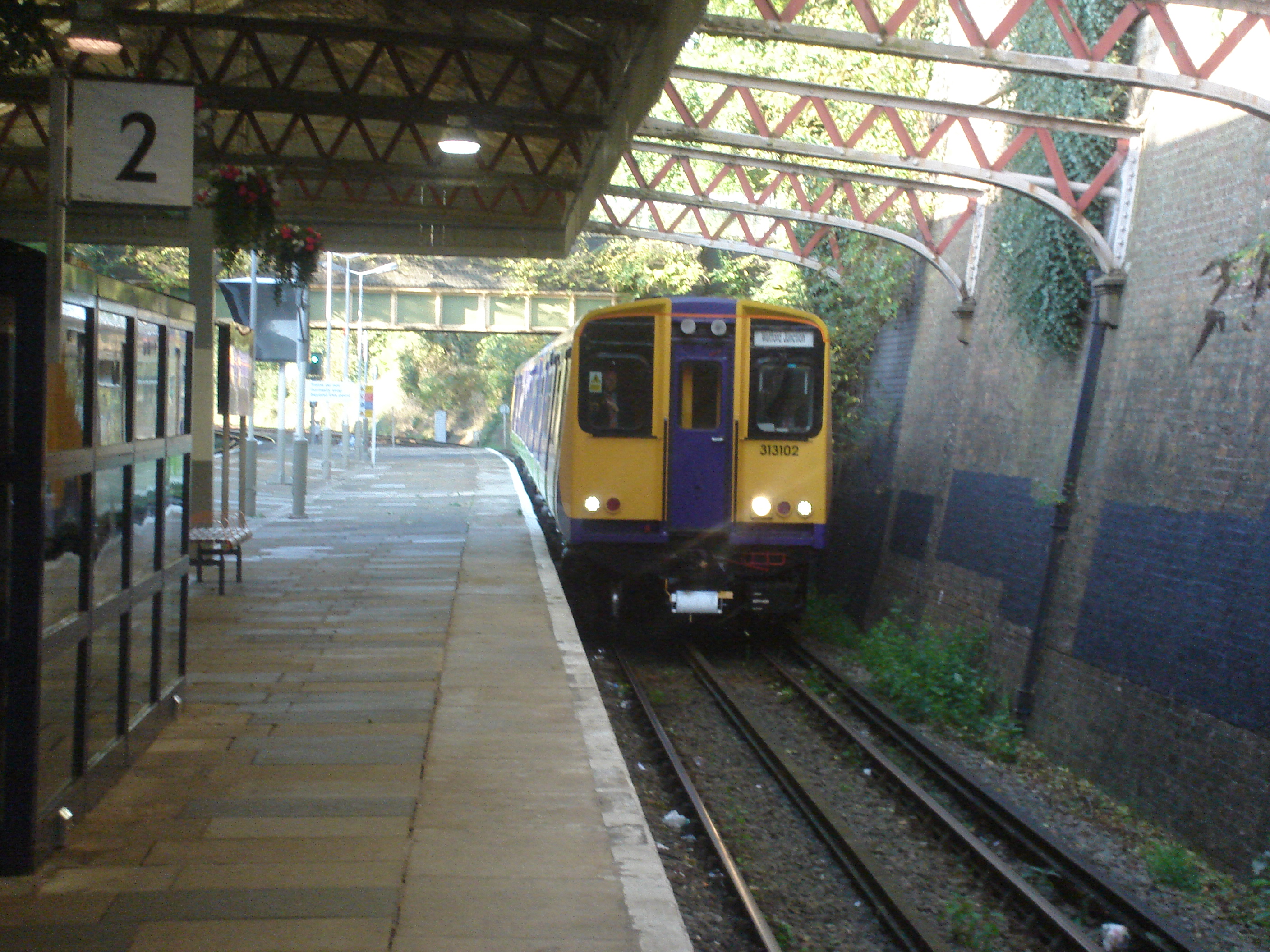|
Bushey Arches Viaduct
Bushey Arches Viaduct is a railway bridge on the West Coast Main Line immediately north of Bushey railway station, between Bushey and Watford, in Hertfordshire, Eastern England, just north-west of London. Design The viaduct consists of five arches in yellow brick and stone and carries the railway across the London to Watford road. Each arch has roughly a span and a rise. The total length of the bridge is about . The voussoirs (insides of the arches) are in rusticated stone. The centre arch (the one crossing the road) is skewed. It has a prominent parapet, below which is a protruding stone band, and impost bands where the arches meet the piers, all of which are in stone. The viaduct is a local landmark and similar in design to the Colne Viaduct, the next major structure on the line in the Birmingham direction.Biddle (2011), p. 119. History The viaduct was built by Robert Stephenson for the London and Birmingham Railway, the world's first long-distance railway, which opened fully ... [...More Info...] [...Related Items...] OR: [Wikipedia] [Google] [Baidu] |
West Coast Main Line
The West Coast Main Line (WCML) is one of the most important railway corridors in the United Kingdom, connecting the major cities of London and Glasgow with branches to Birmingham, Liverpool, Manchester and Edinburgh. It is one of the busiest mixed-traffic railway routes in Europe, carrying a mixture of intercity rail, regional rail, commuter rail and rail freight traffic. The core route of the WCML runs from London to Glasgow for and was opened from 1837 to 1869. With additional lines deviating to Northampton, Birmingham, Manchester, Liverpool and Edinburgh, this totals a route mileage of . The Glasgow–Edinburgh via Carstairs line connects the WCML to Edinburgh, however the main London–Edinburgh route is the East Coast Main Line. Several sections of the WCML form part of the suburban railway systems in London, Coventry, Birmingham, Liverpool, Manchester and Glasgow, with many more smaller commuter stations, as well as providing links to more rural towns. It is one of ... [...More Info...] [...Related Items...] OR: [Wikipedia] [Google] [Baidu] |
London And Birmingham Railway
The London and Birmingham Railway (L&BR) was a railway company in the United Kingdom, in operation from 1833 to 1846, when it became part of the London and North Western Railway (L&NWR). The railway line which the company opened in 1838, between London and Birmingham, was the first intercity line to be built into London. It is now the southern section of the West Coast Main Line. The line was engineered by Robert Stephenson. It started at Euston Station in London, went north-west to Rugby, where it turned west to Coventry and on to Birmingham. It terminated at Curzon Street Station, which it shared with the Grand Junction Railway (GJR), whose adjacent platforms gave an interchange with full connectivity (with through carriages) between Liverpool, Manchester and London. History Early plans The railway engineer John Rennie proposed a railway line from London to Birmingham in 1823, and formed a company to build it by a route through Oxford and Banbury, a route later take ... [...More Info...] [...Related Items...] OR: [Wikipedia] [Google] [Baidu] |
Grade II Listed Bridges In Hertfordshire
Grade most commonly refers to: * Grade (education), a measurement of a student's performance * Grade, the number of the year a student has reached in a given educational stage * Grade (slope), the steepness of a slope Grade or grading may also refer to: Music * Grade (music), a formally assessed level of profiency in a musical instrument * Grade (band), punk rock band * Grades (producer), British electronic dance music producer and DJ Science and technology Biology and medicine * Grading (tumors), a measure of the aggressiveness of a tumor in medicine * The Grading of Recommendations Assessment, Development and Evaluation (GRADE) approach * Evolutionary grade, a paraphyletic group of organisms Geology * Graded bedding, a description of the variation in grain size through a bed in a sedimentary rock * Metamorphic grade, an indicatation of the degree of metamorphism of rocks * Ore grade, a measure that describes the concentration of a valuable natural material in the surroundi ... [...More Info...] [...Related Items...] OR: [Wikipedia] [Google] [Baidu] |
Bridges Completed In 1837
A bridge is a structure built to span a physical obstacle (such as a body of water, valley, road, or rail) without blocking the way underneath. It is constructed for the purpose of providing passage over the obstacle, which is usually something that is otherwise difficult or impossible to cross. There are many different designs of bridges, each serving a particular purpose and applicable to different situations. Designs of bridges vary depending on factors such as the function of the bridge, the nature of the terrain where the bridge is constructed and anchored, and the material used to make it, and the funds available to build it. The earliest bridges were likely made with fallen trees and stepping stones. The Neolithic people built boardwalk bridges across marshland. The Arkadiko Bridge (dating from the 13th century BC, in the Peloponnese) is one of the oldest arch bridges still in existence and use. Etymology The ''Oxford English Dictionary'' traces the origin of the wo ... [...More Info...] [...Related Items...] OR: [Wikipedia] [Google] [Baidu] |
Outer London Defence Ring
The Outer London Defence Ring was a defensive ring built around London during the early part of the Second World War. It was intended as a defence against a German invasion, and was part of a national network of similar "Stop Lines". In June 1940 under the direction of General Edmund Ironside, concentric rings of anti-tank defences and pillboxes were constructed in and around London. They comprised: The London Inner Keep, London Stop Line Inner (Line C), London Stop Line Central (Line B) and London Stop Line Outer (Line A). The Outer London Ring was the strongest and best developed of these, mainly because it could be constructed in open countryside. Work on all the lines was halted weeks later by Ironside's successor, General Alan Brooke,Alanbrooke, Field Marshal Lord (edited by Alex Danchev and Daniel Todman) (2001). War Diaries 1939-1945. Phoenix Press. . who favoured mobile warfare above static defence. The ring used a mixture of natural rivers and artificial ditches up to ... [...More Info...] [...Related Items...] OR: [Wikipedia] [Google] [Baidu] |
Pillbox (military)
A pillbox is a type of blockhouse, or concrete dug-in guard-post, normally equipped with loopholes through which defenders can fire weapons. It is in effect a trench firing step, hardened to protect against small-arms fire and grenades, and raised to improve the field of fire. The modern concrete pillbox originated on the Western Front of World War I, in the German Army in 1916. Etymology The origin of the term is disputed. It has been widely assumed to be a jocular reference to the perceived similarity of the fortifications to the cylindrical and hexagonal boxes in which medical pills were once sold; also, the first German concrete pillboxes discovered by the Allies in Belgium were so small and light that they were easily tilted or turned upside down by the nearby explosion of even medium (240mm) shells. However, it seems more likely that it originally alluded to pillar boxes, with a comparison being drawn between the loophole on the pillbox and the letter-slot ... [...More Info...] [...Related Items...] OR: [Wikipedia] [Google] [Baidu] |
Lithograph
Lithography () is a planographic method of printing originally based on the immiscibility of oil and water. The printing is from a stone ( lithographic limestone) or a metal plate with a smooth surface. It was invented in 1796 by the German author and actor Alois Senefelder and was initially used mostly for musical scores and maps.Meggs, Philip B. A History of Graphic Design. (1998) John Wiley & Sons, Inc. p 146 Carter, Rob, Ben Day, Philip Meggs. Typographic Design: Form and Communication, Third Edition. (2002) John Wiley & Sons, Inc. p 11 Lithography can be used to print text or images onto paper or other suitable material. A lithograph is something printed by lithography, but this term is only used for fine art prints and some other, mostly older, types of printed matter, not for those made by modern commercial lithography. Originally, the image to be printed was drawn with a greasy substance, such as oil, fat, or wax onto the surface of a smooth and flat limestone pla ... [...More Info...] [...Related Items...] OR: [Wikipedia] [Google] [Baidu] |
John Cooke Bourne
John Cooke Bourne (1 September 1814 – February 1896) was a British artist, engraver and photographer,John Hannavy (2013) ''Encyclopedia of Nineteenth-Century Photography.''. p. 196. best known for his lithographs showing the construction of the London and Birmingham Railway and the Great Western Railway. His set of prints were each published as separate book, and became classic representations of the construction of the early railways. Prints were often hand coloured for a vivid picture of events. Biography John Cooke Bourne was born in London, were his father worked as hat-maker in Covent Garden. He was related to the engraver George Cooke, who was his godfather, and became befriended with his son Edward William Cooke, whose uncle, William Bernard Cooke (1778–1855), was also a line engraver of note. After general education, Bourne became a pupil of the landscape engraver John Pye, who had specialised in illustrations for popular annuals and pocket-books. Bourne was furth ... [...More Info...] [...Related Items...] OR: [Wikipedia] [Google] [Baidu] |
Watford High Street Railway Station
Watford High Street is a railway station in Watford, Hertfordshire, United Kingdom. It is served by the Watford DC line on the London Overground network. It is the only station on the line's sole deviation from the West Coast Main Line. History The station was opened by the Watford and Rickmansworth Railway (W&RR) on 1 October 1862, with services running from to . In 1912 a branch was opened to . The line came under the ownership of London and North Western Railway (LNWR), which was absorbed into the London, Midland and Scottish Railway (LMS) in 1923, following the grouping of Britain's railway companies. Additional rail services were introduced to Watford High Street; on 16 April 1917 the Underground Electric Railways Company of London extended its Bakerloo line through this station to , and in 1922 the LNWR completed the suburban Camden to Watford Junction New Line, linking Watford High Street to via the Watford DC Line (shared with the Bakerloo line). After nationali ... [...More Info...] [...Related Items...] OR: [Wikipedia] [Google] [Baidu] |
Watford DC Line
The Watford DC line is a suburban line from London Euston to Watford Junction in Watford, Hertfordshire. Its services are operated by London Overground. The line runs beside the West Coast Main Line (WCML) for most of its length. The London Underground Bakerloo line shares the section of the line from Queen's Park to Harrow & Wealdstone. The rolling stock used on the line are Class 710 "Aventras" made by Bombardier. The "DC" in the title refers to line being electrified using direct current. This was done in the early twentieth century with conductor rails (for compatibility with the London Underground's four-rail system and the now AC/DC-split semi-orbital North London Line). By contrast, the WCML uses overhead alternating current. History Services on this line began when London and North Western Railway (LNWR) completed the Camden to Watford Junction ''new line'' in 1912, to provide additional suburban capacity and more outer-suburban services running non-stop to Eus ... [...More Info...] [...Related Items...] OR: [Wikipedia] [Google] [Baidu] |
Robert Stephenson
Robert Stephenson FRS HFRSE FRSA DCL (16 October 1803 – 12 October 1859) was an English civil engineer and designer of locomotives. The only son of George Stephenson, the "Father of Railways", he built on the achievements of his father. Robert has been called the greatest engineer of the 19th century. Life Robert was born in Willington Quay near Wallsend, Northumberland, the son of George Stephenson and his wife, Frances Henderson. The family moved to Killingworth, where Robert was taught at the local village school. Robert attended the middle-class Percy Street Academy in Newcastle and at the age of fifteen was apprenticed to the mining engineer Nicholas Wood. He left before he had completed his three years to help his father survey the Stockton and Darlington Railway. Robert spent six months at Edinburgh University before working for three years as a mining engineer in Colombia. When he returned his father was building the Liverpool and Manchester Railway, and Robe ... [...More Info...] [...Related Items...] OR: [Wikipedia] [Google] [Baidu] |
Bushey
Bushey is a town in the Hertsmere borough of Hertfordshire in the East of England. It has a population of over 25,000 inhabitants. Bushey Heath is a large neighbourhood south east of Bushey on the boundary with the London Borough of Harrow reaching elevations of above sea level. History The first written record of Bushey is its entry in the Domesday Book of 1086, which describes a small agricultural village named 'Bissei' (which later became 'Biss(h)e' and then 'Bisheye' during the 12th century). However, chance archaeological findings of Stone Age tools provide evidence that the area was inhabited as far back as the Palaeolithic period. The town also has links to the Roman occupation of Britain, with the main road running through it being Roman; sites of possible Roman villas being unearthed in the area; and a Roman tessellated pavement was discovered near Chiltern Avenue. The origin of the town's name is not fully known. In terms of the original name, "Bissei," an early t ... [...More Info...] [...Related Items...] OR: [Wikipedia] [Google] [Baidu] |



.jpg)




